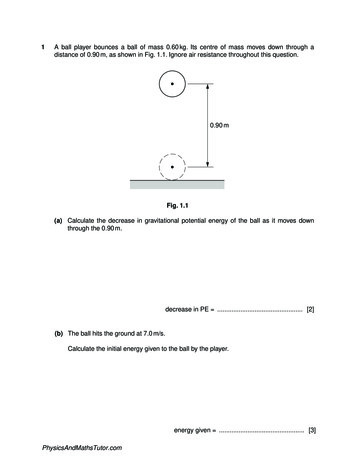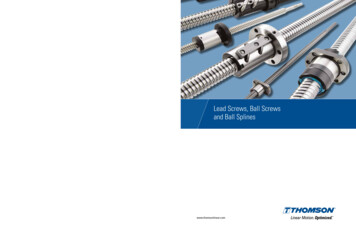
Transcription
1A ball player bounces a ball of mass 0.60 kg. Its centre of mass moves down through adistance of 0.90 m, as shown in Fig. 1.1. Ignore air resistance throughout this question.0.90 mFig. 1.1(a) Calculate the decrease in gravitational potential energy of the ball as it moves downthrough the 0.90 m.decrease in PE . [2](b) The ball hits the ground at 7.0 m/s.Calculate the initial energy given to the ball by the player.energy given . [3]PhysicsAndMathsTutor.com
(c) On another occasion, the player throws the ball into the air, to a height of 4.0 m abovethe ground. The ball then falls to the ground.During the impact, 22% of the ball’s energy is lost.(i)Suggest one reason why energy is lost during bouncing. [1](ii)Calculate the height to which the ball rises after the bounce.[2](iii)An observer who sees the ball bounce says, “That ball should be slightly warmerafter that bounce.”Explain why the observer’s statement is true. [1][Total: 9]PhysicsAndMathsTutor.com
2Fig. 5.1 shows a model cable-car system. It is driven by an electric motor coupled to a gearsystem.gears6.0melectricmotor2.0 msmoothpulleymodelcable-carFig. 5.1The model cable-car has a mass of 5.0 kg and is lifted from the bottom pulley to the top pulley in40 s. It stops automatically at the top.(a) Calculate(i)the average speed of the cable-car,average speed . [2](ii)the gravitational potential energy gained by the cable-car,gravitational potential energy gained . [2]PhysicsAndMathsTutor.com
(iii)the useful output power of the driving mechanism.power . [2](b) How would the electrical power input to the motor compare with your answer to (a)(iii)?. [1][Total: 7]PhysicsAndMathsTutor.com
3A bob of mass of 0.15 kg is tied at the end of a cord to form a simple pendulum 0.70 m long.The upper end of the cord is fixed to a support and the pendulum hangs vertically. A peg is fixed0.50 m vertically below the support, as shown in Fig. 2.1.support0.50 mpegbob 0.10 m0.20 m0.30 mgroundFig. 2.1The mass is pulled to the right, until it is in the position shown in Fig. 2.1.Ignore air resistance throughout this question.(a) Calculate the gravitational potential energy of the bob, relative to the ground, when the bob isin the position shown in Fig. 2.1.gravitational potential energy . [2]PhysicsAndMathsTutor.com
(b) The bob is released and swings to the left.(i)Calculate the maximum kinetic energy of the bob.kinetic energy . [4](ii)Calculate the maximum velocity of the bob.velocity . [2](iii)As the pendulum swings to the left of vertical, state the maximum height above theground that is reached by the bob. [1](iv)On Fig. 2.1, use your ruler to draw carefully the pendulum when the bob is at its maximumheight on the left.[3][Total: 12]PhysicsAndMathsTutor.com
4A boy drops a ball of mass 0.50 kg. The ball falls a distance of 1.1 m, as shown in Fig. 6.1. Ignoreair resistance throughout this question.1.1 mFig. 6.1(a) Calculate the decrease in gravitational potential energy of the ball as it falls throughthe 1.1 m.decrease in potential energy . [2](b) The ball bounces and only rises to a height of 0.80 m.(i)Calculate the energy lost during the bounce.energy lost . [1](ii)Suggest one reason why energy is lost during the bounce. [1]PhysicsAndMathsTutor.com
(c) On another occasion, the boy throws the ball down from a height of 1.1 m, giving it an initialkinetic energy of 9.0 J.Calculate the speed at which the ball hits the ground.speed . [3][Total: 7]PhysicsAndMathsTutor.com
1A wind turbine has blades, which sweep out an area of diameter 25 m.25 mbladesFig. 5.1(a) The wind is blowing directly towards the wind turbine at a speed of 12 m / s. At this windspeed, 7500 kg of air passes every second through the circular area swept out by theblades.(i)Calculate the kinetic energy of the air travelling at 12 m / s, which passes throughthe circular area in 1 second.kinetic energy . [3](ii)The turbine converts 10% of the kinetic energy of the wind to electrical energy.Calculate the electrical power output of the turbine. State any equation that youuse.power . [3]PhysicsAndMathsTutor.com
(b) On another day, the wind speed is half that in (a).(i)Calculate the mass of air passing through the circular area per second on this day.mass . [1](ii)Calculate the power output of the wind turbine on the second day as a fraction ofthat on the first day.fraction . [3][Total: 10]PhysicsAndMathsTutor.com
2A farmer uses an electric pump to raise water from a river in order to fill the irrigation channelsthat keep the soil in his fields moist.water poursinto channelelectricpumpfieldwater risesup tube3mirrigationchannelriverFig. 5.1Every minute, the pump raises 12 kg of water through a vertical height of 3 m.(a) Calculate the increase in the gravitational potential energy of 12 kg of water when it israised 3 m.increase in gravitational potential energy . [3](b) Calculate the useful power output of the pump as it raises the water.power . [3][Total: 6]PhysicsAndMathsTutor.com
3(a) Name the process by which energy is released in the core of the Sun. [1](b) Describe how energy from the Sun becomes stored energy in water behind a dam. [3](c) Data for two small power stations is given in Table 2.1.input to power stationoutput of power stationgas-fired100 MW25 MWhydroelectric90 MW30 MWTable 2.1(i)State what is meant by the efficiency of a power station. [1](ii)Use the data in Table 2.1 to explain that the hydroelectric station is more efficientthan the gas-fired power station. [1][Total: 6]PhysicsAndMathsTutor.com
4A cyclist rides up and then back down the hill shown in Fig. 3.1.top of hill14 mstarting andfinishing pointFig. 3.1The cyclist and her bicycle have a combined mass of 90 kg. She pedals up to the top andthen stops. She turns around and rides back to the bottom without pedalling or using herbrakes.(a) Calculate the potential energy gained by the cyclist and her bicycle when she hasreached the top of the hill.potential energy . [2](b) Calculate the maximum speed she could have when she arrives back at the startingpoint.speed . [3]PhysicsAndMathsTutor.com
(c) Explain why her actual speed will be less than that calculated in (b). [1][Total: 6]PhysicsAndMathsTutor.com
(c) On another occasion, the pla yer throws the ball into the air, to a height of 4.0 m above the ground. The ball then falls to the ground. During the impact, 22% of the ball s energy is lost.










